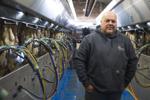A cow laying on barn hay at Mesman Farm just east of La Conner let out a deep moo Wednesday as she worked to deliver her first calf.
Farm owner Ben Mesman hopped behind the barn gate to help his dairy cow, yanking her newborn calf by the hooves and welcoming it into the world.
The calf shivered in the cool March air as it let out squeaky moos, waiting for its mother to lick it clean.
Calf births are not out of the ordinary at Mesman Farm, as they ensure future generations of organic dairy cows.
The future of the fifth-generation family dairy farm and the dairy industry in Skagit County, though, is less certain.
“I just don’t know if there’s a future in dairy in Western Washington,” Mesman said.
Ben’s wife, Chelsy Mesman, said they love farming and raising cows, but the industry is so expensive that it’s hard to stay in it.
The majority of the county’s dairy farmers either break even or lose money, Ben Mesman said. Two dairies will be going out of business in the coming months.
Shrinking numbers
Jason Vander Kooy grew up on his family’s dairy farm.
Now, he owns the family farm, Harmony Dairy, west of Mount Vernon.
As Vander Kooy stood beside his home at his second farm location off McLean Road on Feb. 24, he reminisced about the various dairies in the area when he was a child.
He pointed out at the landscape, where small dairy farms once operated.
“All around you, there were these farms spotted throughout the farmland here,” Vander Kooy said.

Harmony Dairy bought smaller farms that went out of business, leaving it the only dairy remaining in the area, he said.
The Washington State University Skagit County Extension shows 23 dairy farms countywide at the end of 2020, three less than at the start of the year.
There are currently 20 licensed dairies in the county, according to the state Department of Agriculture. Statewide, there are about 360 dairy farms, according to the Dairy Farmers of Washington.
Don McMoran, director of the county extension, said the dairy industry “feels like it’s sliding fast.”
For perspective, McMoran’s grandfather came to Washington in 1909 with dreams of operating a dairy. At the time, there were thousands of small dairy farms throughout the county.
A generation later, during his father’s childhood, there were about 600 dairy farms countywide, and there were about 200 during McMoran’s childhood.
McMoran said some dairy farmers got pushed out after their banks stopped approving loans due to debt from the previous year.
The current dairy industry in the county consists of fewer large farms, such as Harmony Dairy, and more small organic farms, such as Mesman Farm.
There was a shift in the 1990s for dairy farmers.
“You either got big, got out or you went organic,” McMoran said.
A struggle to get by
Dairy farms are capital intensive and much of the equipment necessary is purchased at a fixed rate, meaning it costs the same regardless of how many cows a dairy owns.
Farmers with more cows will be able to absorb costs better than farmers with fewer cows.
“The scale of economics plays a big role in farming,” Vander Kooy said.
Along with upfront capital, the price of milk and the cost of cow feed are critical to dairy farmers.
For the past several years, milk prices were low at an average of $16 per 100 pounds, Vander Kooy said.
When the market was starting to look up, the COVID-19 pandemic brought it back down.
Vander Kooy said Harmony Dairy breaks even when milk prices are $18 per 100 pounds.
Now, milk prices are strong, Vander Kooy said. Milk is selling between $22 and $23 per 100 pounds.
The U.S. Department of Agriculture has predicted higher milk prices nationwide in 2022. But the higher prices are coming with higher feed costs.
Because milk is a commodity, global politics and the global economy play a role in the price of milk for conventional dairy farmers.
Higher prices in other commodity crops can trigger milk prices to go up, said Dwayne Faber, owner of High Valley Dairy near Mount Vernon.
Right now, the price of soybeans and corn are up, which bumps up milk prices, he said.
“This year will be a welcome relief for a lot of our farmers,” Faber said.
Organic milk is sold at a different price than commodity milk.
In 2006, the Mesmans went organic to stay competitive as a small dairy.
At the time, the price of commodity milk was low and organic milk was selling for about $32 per 100 pounds, Ben Mesman said.
Now, the price of organic milk is about $25 per 100 pounds, which is not much higher than the price of commodity milk.
The price of organic milk began to drop in 2015. Since then, Mesman Farm lost about half its revenue, Ben Mesman said.
The Mesmans have considered getting out of the dairy industry. They are waiting to see what this year brings.
Finding ways to save
Similar to Mesman Farm and Harmony Dairy, High Valley Dairy grows the majority of the feed needed for its cows, curbing the cost of purchasing and transporting feed from other farms.
Faber does what is called upcycling waste, turning potato and Brussels sprout scraps from local farms into nutritious feed for his cows.
Vander Kooy, who grows about 85% of the feed his cows need, said growing feed is still costly due to the equipment and land needed, but it provides security by keeping dairy farmers from having to rely on anyone else.
The Mesmans grow enough grain and hay that they can sell some of it after feeding their cows, but last summer’s drought hurt their hay crop.
Usually, they sell about $30,000 worth of hay to other farmers, but this year they had to buy $50,000 in hay because of the drought.
The Mesmans have taken measures to cope with low milk prices and increasing costs of feed, labor and equipment.
They opened a farm store on their property to sell their organic meat and they bought a robotic milker, which saves money on labor and feed because the data it collects tells them exactly how much food the cows need.
A passion for farming
Despite the challenges they face, dairy farmers keep farming because it’s their passion, said McMoran, who grew up on a farm.
“I feel an obligation that, if anything were to happen to my parents, I would continue on their legacy,” McMoran said. “That’s what our ancestors have always wanted of us. Also, it’s in your blood, it’s a part of who you are, it’s ingrained in you.”
Vander Kooy is teaching his son how to be a dairy farmer, just as his dad did when he and his brother were young.
“I couldn’t see myself doing anything else,” Vander Kooy said.
Faber continues to dairy farm because he likes working with cows, the land and his employees, and he loves growing food for people.
He bought another dairy in Astoria, Oregon, to diversify his business.
The milk prices in Oregon were higher than Washington last year and labor costs are lower partly because state law doesn’t require farm owners to pay their workers overtime.
“It feels like the future is not in Western Washington,” Faber said.
Source: goskagit.com













